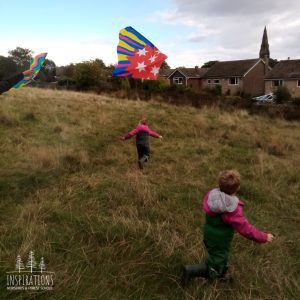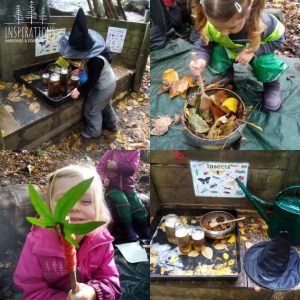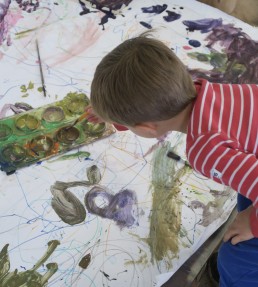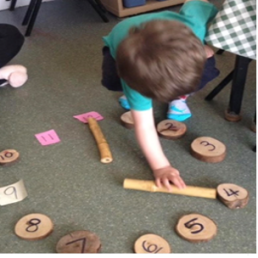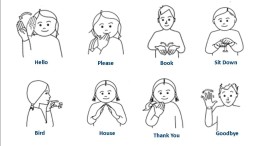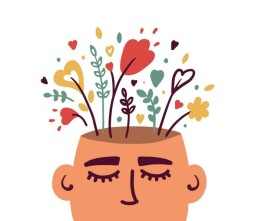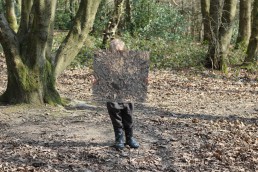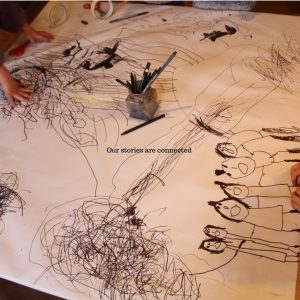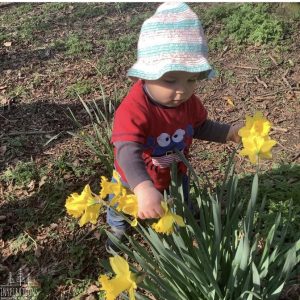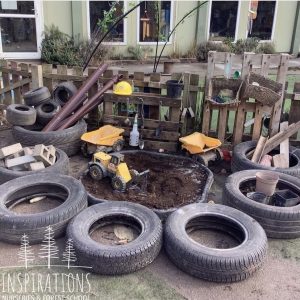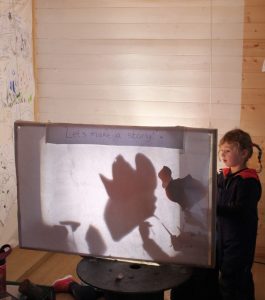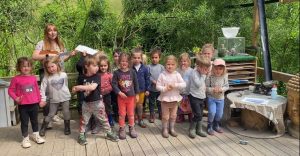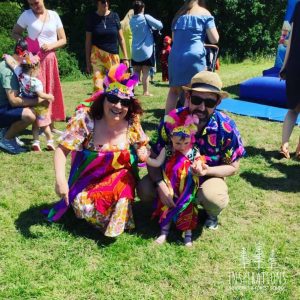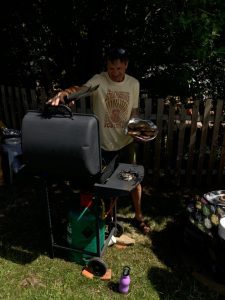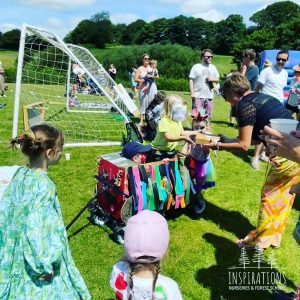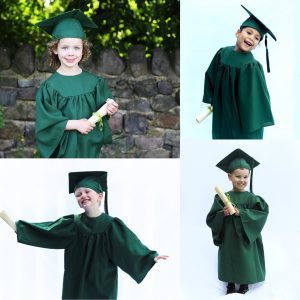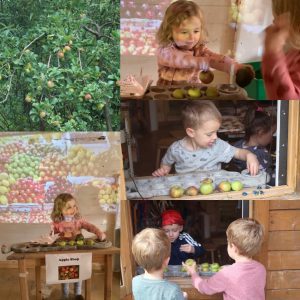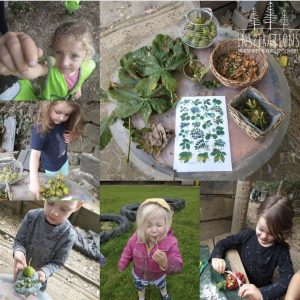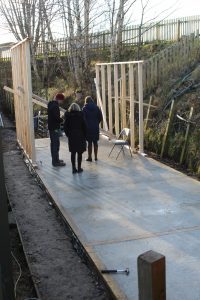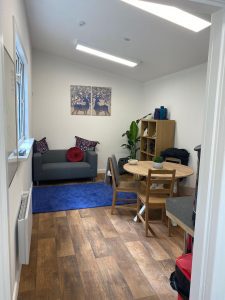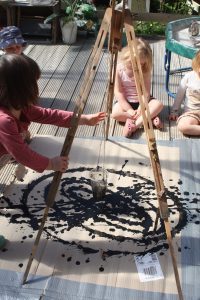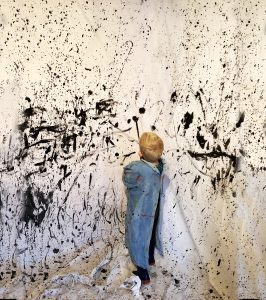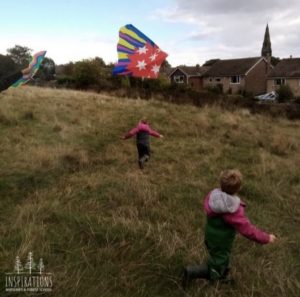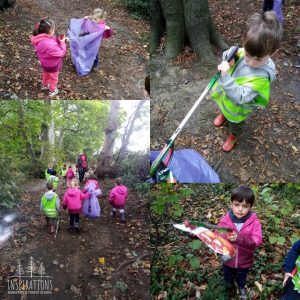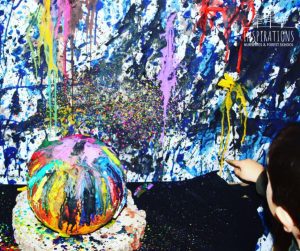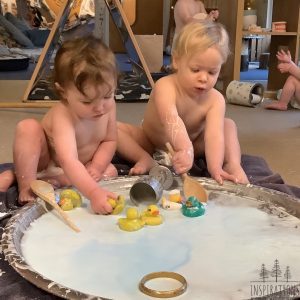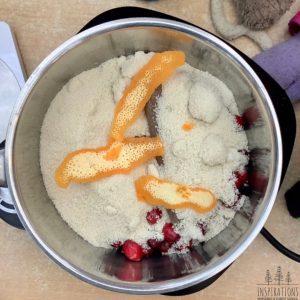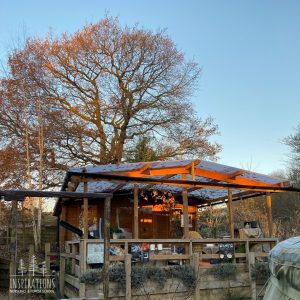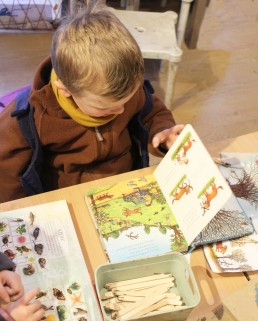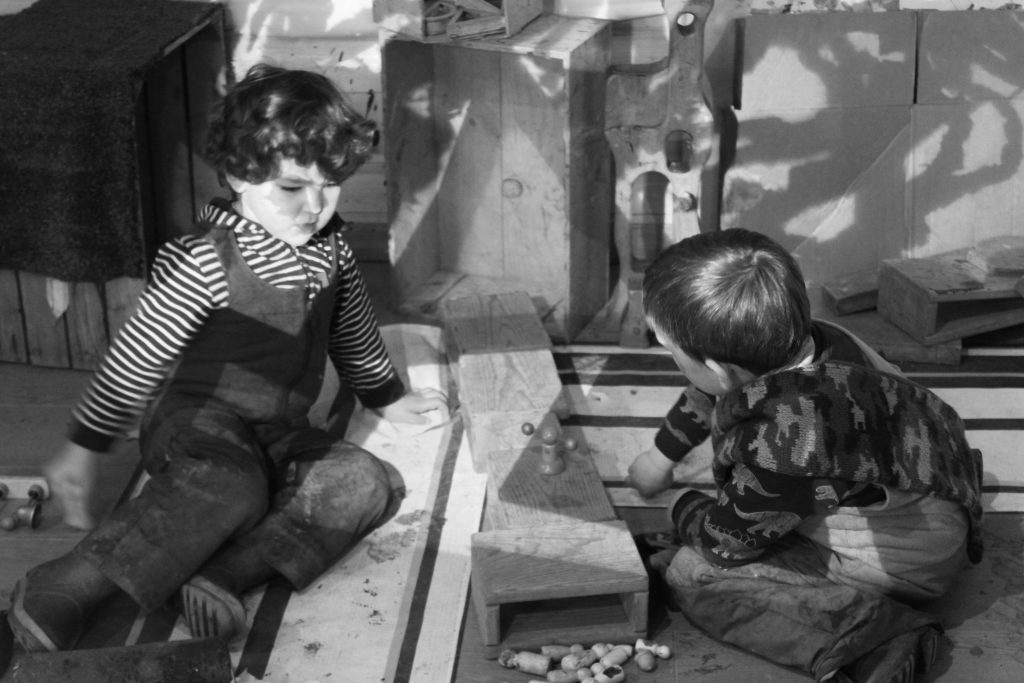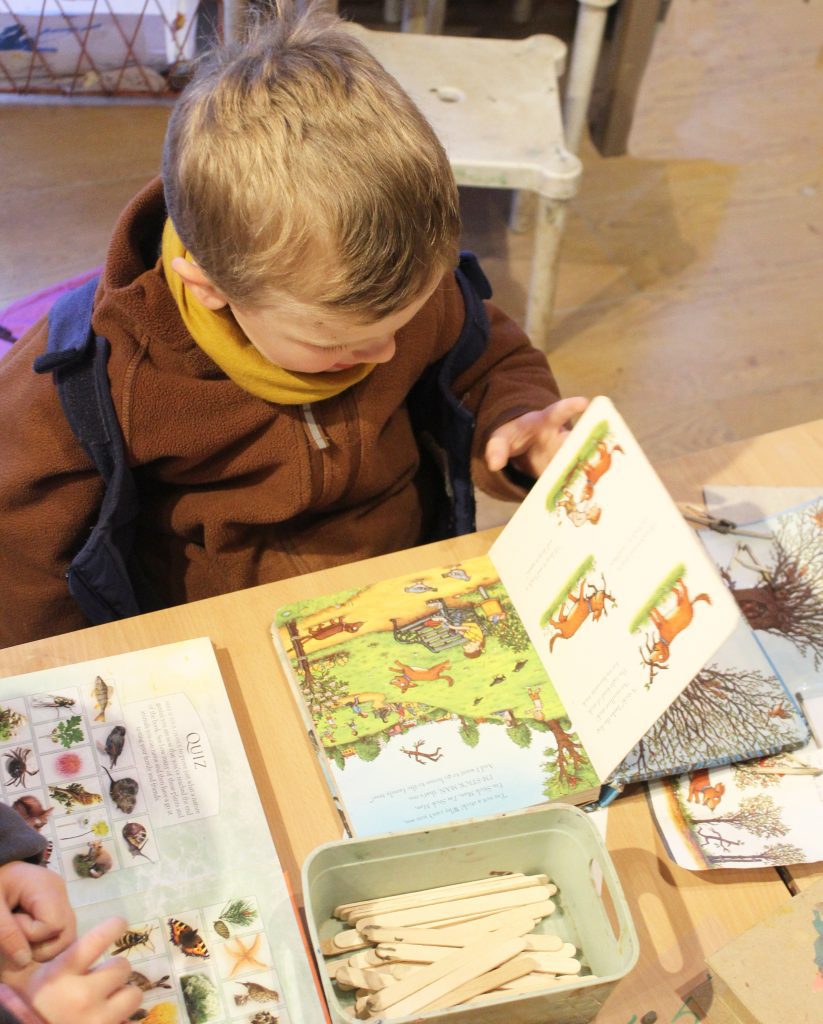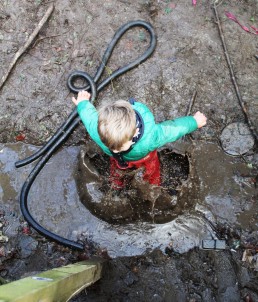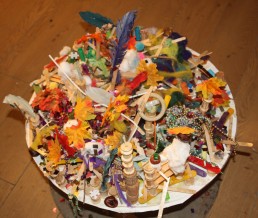Reduce Reuse Recycle

Welcome to our Inspirations Eco- school blog.
We can’t wait to share all our activities and eco-projects that will be happening in our setting.
The Early Years is a crucial time to install a love and respect for the environment in our children and
we are so lucky at Inspirations to have the perfect environment to do this. We are committed to
providing our children with a green and sustainable education.
Our Forest School is offered all year round as part of our daily pre-school activities. Between these
off-site sessions forest school activities take place on site around our veg garden, wildlife pond and
within our extensive grounds. We have implemented various eco-friendly practices to reduce our carbon footprint by encouraging reusable water bottles, recycling paper, taking part in this year’s Big Battery Hunt, and even making our own paper!
Our outdoor area is a nature inspired learning space. Our children have enjoyed making bug hotels
to provide a safe hideaway for wildlife. Our well-built hotels can shelter anything from hedgehogs to
toads, solitary bees to bumblebees, ladybirds to woodlice.
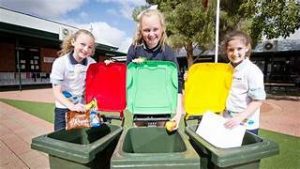
We also participated in Plant life's annual campaign No Mow May. Educating our children on the
importance of boosting flowers, and nectar, available to pollinating insects such as bees, butterflies,
and moths. This then also allows spring flowers to set seed and plants to establish themselves in
advance of the summer.
At Inspirations we believe that by introducing eco-friendly and environmental education at an early
age, we are nurturing a generation of responsible and environmentally conscious citizens. Our vision is that all our children grow up with an understanding of the impact their actions have on the planet and are developing a sense of responsibility towards it.
We are so excited to be starting our eco-school journey in the new academic year, working towards
our first Eco-Schools Green Flag. We also have a community project that we are so excited to get
involved with and can’t wait to share with you.
Together, we can make and create a greener and more sustainable future.
Tara Slade.
Embracing the process
Personal growth through art
Children’s art can provoke many reactions but there is so much more going on 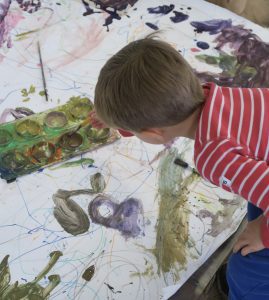 under the surface than what can be seen. Art allows children to reconstruct and assimilate their experiences and observations, to create meaning to the world around them. Especially for those who are just beginning to learn how to read and write, as shapes and symbols become a communication tool and a personal language.
under the surface than what can be seen. Art allows children to reconstruct and assimilate their experiences and observations, to create meaning to the world around them. Especially for those who are just beginning to learn how to read and write, as shapes and symbols become a communication tool and a personal language.
Adults often judge children’s art by adult standards, assessing it on its execution. However what a child creates is a unique representation of their own experiences and development. Children are able to produce artwork with distinctive qualities that no adult can replicate.
Journey of discovery
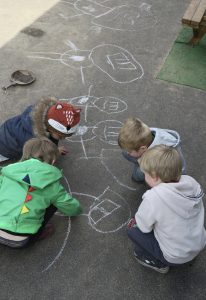 Children are often shown the ‘right’ way when learning numbers and letters, whereas art opens up a world of possibilities where diversity and individuality can be celebrated. There may be a temptation for educators to fix, provide templates or insist all children follow the same objective. But this extinguishes the activation of creativity and invention, whilst subconsciously enforcing the notion that there is a ‘right’ way to do art.
Children are often shown the ‘right’ way when learning numbers and letters, whereas art opens up a world of possibilities where diversity and individuality can be celebrated. There may be a temptation for educators to fix, provide templates or insist all children follow the same objective. But this extinguishes the activation of creativity and invention, whilst subconsciously enforcing the notion that there is a ‘right’ way to do art.
In contrast, the Reggio Emilia approach we implement at Inspirations allows children to explore new materials and mediums by themselves, for themselves. Keeping the environment and activity open-ended provides children the freedom and responsibility to make their own decisions. Materials are thoroughly explored, skills and knowledge are repeated and reinforced in their own time, and children become masters of their own learning. Children can put in to practice the ‘hundred languages’, communicating, expressing and creating a dialogue of their own... one which is rich and colourful and not limited to an adult’s expectation.
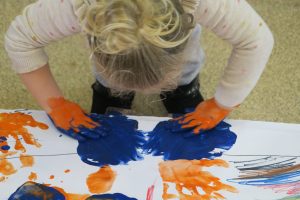 The process of a creation is equally a process for the child. Simple scribbles can be a representation of an object in action or an experiment on pressure and shape. Figures and shapes can become parts of a narrative that slowly emerge. Therefore, when a child is put at the centre of their learning they feel empowered and encouraged to fully immerse themselves in their process rather than fixating on the outcome. Ideas of right and wrong fade away and curiosity and discovery take precedence. Ultimately, providing the child harmony between body and soul, deepening their connection emotional, cognitively and physically to their sense of self.
The process of a creation is equally a process for the child. Simple scribbles can be a representation of an object in action or an experiment on pressure and shape. Figures and shapes can become parts of a narrative that slowly emerge. Therefore, when a child is put at the centre of their learning they feel empowered and encouraged to fully immerse themselves in their process rather than fixating on the outcome. Ideas of right and wrong fade away and curiosity and discovery take precedence. Ultimately, providing the child harmony between body and soul, deepening their connection emotional, cognitively and physically to their sense of self.
Julia Lai
Pre-school Maths
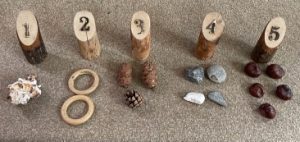
Mathematical development is complex. Developing a secure grasp of early mathematical ideas takes time. Even if a child appears to be engaging successfully in mathematical activities, such as reciting the count sequence, they may not understand the meaning of the numbers they are saying. It is important that practitioners are aware of typical development of mathematical skills and concepts and have the knowledge to support children’s understanding.
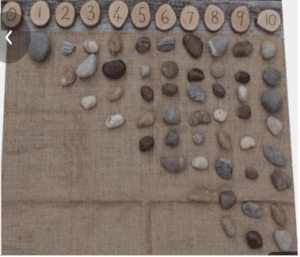 We at Inspirations have observed how beneficial the use of loose parts is for maths development. When children transform objects in their creative play, they are unknowingly problem-solving and building their imaginations. For example, when sticks and stones become food, mathematical concepts are natural encouraged as they assess the shapes, sizes and amounts they need. Often children will simply use loose parts to line up, order in size, number and make patterns.
We at Inspirations have observed how beneficial the use of loose parts is for maths development. When children transform objects in their creative play, they are unknowingly problem-solving and building their imaginations. For example, when sticks and stones become food, mathematical concepts are natural encouraged as they assess the shapes, sizes and amounts they need. Often children will simply use loose parts to line up, order in size, number and make patterns.
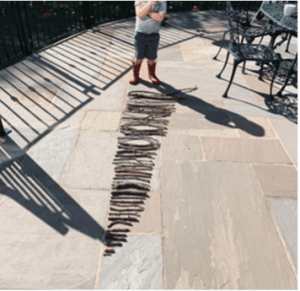 Pattern is extremely important for maths development. Recognising number through pattern and subitising (instantly recognising without counting) are skills we can help to develop by using a wide range of ideas and resources. Children will quickly recognise what the patterns on dice represent as numbers and progress to adding two sets of number patterns through board games and play.
Pattern is extremely important for maths development. Recognising number through pattern and subitising (instantly recognising without counting) are skills we can help to develop by using a wide range of ideas and resources. Children will quickly recognise what the patterns on dice represent as numbers and progress to adding two sets of number patterns through board games and play.
Dots seen in a regular pattern representing numbers has been used to support addition and subtraction in schools for many years.
. . .
. . = 7 . . = 3
. .
.
Eventually children become familiar with each number representation as they see these same patterns while recognising the shapes they make.
Numicon uses familiar shapes to represent numbers. Exploration of these resources at a young age will familiarise a child with their shapes and colours and eventually numbers will be assigned to each shape. As the shapes are 1-10 they can be used for ‘number bonds to ten’ by fitting the shapes together to form the 10th shape. They can also be used to support ‘adding beyond 10’ or ordering them as numbers and matching the numerals.
![]()
Conceptualising number through pattern can be supported in many other ways such as playing dominoes, using dice in a board game, playing cards or using tens frames.
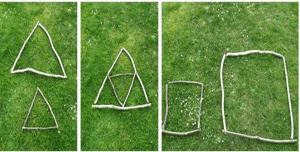 Challenges and activities to support maths progression can be planned regularly with adult support. Practitioners can work with children, sensitively intervening with questioning and prompts. Metacognition is the ability to reflect on your own thinking processes. Practitioners should encourage children to explain their thinking and strategies when solving mathematical problems. This enables children to gain an insight into their own thinking, learn from their mistakes, and develop problem-solving skills. Questions such as, ‘How did you…?’, ‘Why does this…?’, encourages children to reflect more deeply and to put their thought processes into words. Our practitioners seize chances to reinforce mathematical vocabulary in everyday situations. For example, by commenting on which child is standing ‘first’, ‘second’, or ‘last’ in line, which child has ‘more than’ or ‘fewer’ objects than another child and how many steps it takes to climb the stairs. The introduction of more refined mathematical vocabulary is then slowly increased through focused activities.
Challenges and activities to support maths progression can be planned regularly with adult support. Practitioners can work with children, sensitively intervening with questioning and prompts. Metacognition is the ability to reflect on your own thinking processes. Practitioners should encourage children to explain their thinking and strategies when solving mathematical problems. This enables children to gain an insight into their own thinking, learn from their mistakes, and develop problem-solving skills. Questions such as, ‘How did you…?’, ‘Why does this…?’, encourages children to reflect more deeply and to put their thought processes into words. Our practitioners seize chances to reinforce mathematical vocabulary in everyday situations. For example, by commenting on which child is standing ‘first’, ‘second’, or ‘last’ in line, which child has ‘more than’ or ‘fewer’ objects than another child and how many steps it takes to climb the stairs. The introduction of more refined mathematical vocabulary is then slowly increased through focused activities.
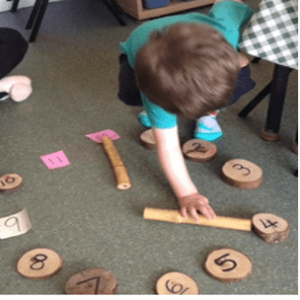 Physical whole-body movement and gestures support the learning of mathematics, for example, moving along a physical number line or jumping and clapping while counting. Practitioners should also encourage children’s use of fingers which are important manipulatives, initially useful for supporting counting and later for counting in groups.
Physical whole-body movement and gestures support the learning of mathematics, for example, moving along a physical number line or jumping and clapping while counting. Practitioners should also encourage children’s use of fingers which are important manipulatives, initially useful for supporting counting and later for counting in groups.
It is important to realise that not all maths activities need specific or specialised resources, anything can be counted and numbers can be formed with most materials. During Covid lockdown, Inspirations provided a virtual nursery and the first activity we suggested was to go for a walk and collect natural resources. These were then used in our future activities to ensure that all children could take part without having to purchase anything.
Maths opportunities are all around us. We should encourage learning in this area through numerical songs, games, activities and play, to help children develop a keen attitude for maths, so they can follow this interest when it becomes a lot trickier in formal school!
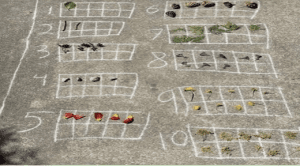
Deborah Keane
Other Ways to Communicate
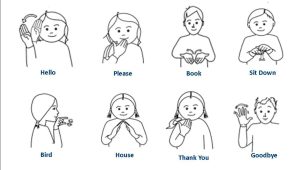
When we talk about communication people often only think about speech, but there are lots of different ways to communicate. Eye contact, body language, facial expressions, gestures, and drawing and writing are daily tools we might use for sharing information.
At Inspirations we follow the Reggio Emilia approach, where one of our key principles is the ‘hundred languages of learning’. The principle refers to communication and the one hundred ways children can express and process the world around them. It provides children opportunities to engage through arts and media, light and shadow and music.
At Inspirations we implement this approach through our daily sessions. The pre-school children decide where they would like to go at choosing times. They may choose to stay in the yurt and outdoor classroom, where the environment is carefully set up by trained staff which use the children’s interests to extend their learning, or they may decide to go off site. Our child-led curriculum provides forest school and art studio workshops twice a day, for two hours. Working in small groups in the art studio ensures that the children can work intimately on projects, expressing their thoughts and ideas through a diverse range of mediums. The forest school sessions provide a breadth of natural resources for the children, and with the guidance from trained staff, a world of beauty, connection, movement and autonomy.
Communicating in all the different ways may come easier to some people than others and some may find them all challenging. Some people may have conditions which can affect the way they communicate. For example, someone who is autistic will often have difficulties when it comes to communicating, especially in social situations. Some people struggle to verbally communicate so will need to learn other non-verbal methods.
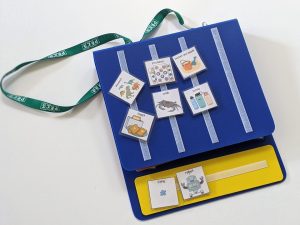 In our nursery each room is supplied with visual aids. This picture-based resource enables babies and children that are preverbal to interact with us. Visuals provide good support to a verbal instruction and help children to understand and make connections. When necessary, we also use Boardmaker which is a software often used across Leeds to support children with Special Educational Needs and Disabilities (SEND) as well as children with English as an additional language. Using resources that they may use when they move on from us is important for consistency. Some children may need PECS, which is a Picture Exchange Communication System. This is a unique communication tool using Boardmaker to enable children to communicate their wants and needs. The programme involves another person acting as the communicative partner, responding to the child's requests. It teaches children that communication is an exchange and how to put words together to form a sentence.
In our nursery each room is supplied with visual aids. This picture-based resource enables babies and children that are preverbal to interact with us. Visuals provide good support to a verbal instruction and help children to understand and make connections. When necessary, we also use Boardmaker which is a software often used across Leeds to support children with Special Educational Needs and Disabilities (SEND) as well as children with English as an additional language. Using resources that they may use when they move on from us is important for consistency. Some children may need PECS, which is a Picture Exchange Communication System. This is a unique communication tool using Boardmaker to enable children to communicate their wants and needs. The programme involves another person acting as the communicative partner, responding to the child's requests. It teaches children that communication is an exchange and how to put words together to form a sentence.
In our baby rooms we use Makaton during singing times and for other frequent words such as ‘more’ or ‘drink’. Makaton involves signing key words, using a spoken word at the same time. Although it is not an official form of signing, it is based on signs used in the British Sign Language. Makaton was developed for very young children with special needs or other communicative challenges. It is helpful for someone who can hear but has difficulties with communication as it uses symbols, verbal words and hand signs.
Kayleigh Woolger
The well-being of employees
The Oxford Language Dictionary describes well-being as ‘the state of being comfortable, healthy or happy’.
Unfortunately, coping and addressing mental health conditions now appears to be an integral part of the society we live in and even more so since the COVID-19 pandemic. It seems to have become the way of the world and statistics show that 1 in 6.8 people experience mental health problems in the workplace, and stress, anxiety and depression accounts for 51% of all work-related ill health cases.
Stress within the early years sector is particularly bad at the moment. Nursery World reported that 1 in 4 early years workers are considering leaving. Pressures, such as staff recruitment are a big contributing factor to the impact on the quality of employees work life. Having to substitute quality qualified employees with staff from agencies, who don’t know the routines and the children in our care, inevitably creates a very stressful day.
Another area that is becoming more recognised as an area to support employees within is the Menopause/Perimenopause. Although women may experience different symptoms through the change, we are learning to meet their needs by offering additional support with shift times (due to sleepless nights), doctor appointments and more understanding towards changes in behaviour and attitudes.
Supporting employees with their well-being is paramount in helping them cope mentally and spiritually. Within Inspirations we do our best to uphold this as we are aware women, of which we are predominately based, in full-time employment are nearly twice as likely to have a common mental health problem as opposed to that of men.
There are so many avenues nowadays that support those suffering and struggling, for example helplines (MIND and Samaritans), NHS talking therapies (IAPT), apps such as CALM, social media, and podcasts. It is a subject that is a lot more recognised and talked about for both MEN and WOMEN.
Below are some of the things we do to support staff wellbeing:
- Shout out board – staff and parents can add to this and these are read out in our staff meetings
- Termly supervisions and yearly appraisals are held to check in with staff
- Hot meals available, as well as condiments such as tea, coffee and juice
- Fruit and healthy snacks for break times
- Everyday essentials such as feminine products deodorant etc
- Well-being program – downloadable app to help and support as well as a 24/7 advice line that can put you in touch with counsellors (with 6 free sessions)
- Team building activities
- Comfy, relaxing staff room
- Paid training
- Food provided during staff meetings
- Birthday cakes to celebrate individual birthdays
- Christmas party
Having an open doors policy to the office is highlighted within our policy and vital to support the staff the best we can. Management are always available if staff require a friendly ear. We also have a mental health first aider on site who can help advise employees, as well as room leaders and deputy room leaders trained in ‘supporting staff with well-being in the early years.’
If you have been reading this and it has given you the confidence to express your anxieties, stress, well-being then please see below a couple of contacts of agencies that can help…
MIND - 03001233393
SAMARITANS – 988
Ashleigh Benson
2022 Unwrapped
Another year is coming to an end, we have welcomed many new families to the Inspirations community, our babies are now toddlers, our toddlers now pre-schoolers and we said goodbye to our capable school leavers. What a year it has been!
Last January as a nursery we made a new years resolution, to continue to learn from nature and make the right choices for our children and our planet, and this is something we stuck to. Our children here continue to inspire us daily, their curiosity and passion to lead their own learning guides us as the educators to continue to grow as people and as a setting. The toddler room has seen an exciting new outdoor classroom meaning they are outside most of the day, preparing them for our outdoor learning and forest school in Pre-school.
Let's take a look at each month as we say goodbye to 2022 and hello to 2023.
January
We welcomed in January 2022 with pink and orange skies! The bonus of our outdoor setting in Pre-School means the sky is our ceiling, literally.
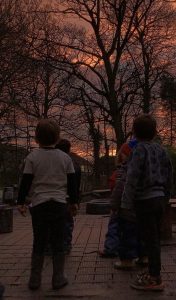
February
A new interest emerged in the Art Studio, the children's imaginations lead them down a path of story telling. Little did we know this was the start of a 6 month project. Watch the video below to see how it begun.
March
The first signs of spring emerged alongside World Book Day, an annual favourite at Inspirations. We celebrated Spring Equinox by Forest School and The Art Studio teaming up for a full day in the forest. We took our lunch with us and ate it beneath the trees, it was a wonderful opportunity for the children to have the freedom of time and space and to learn from our forest.
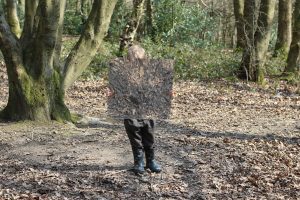
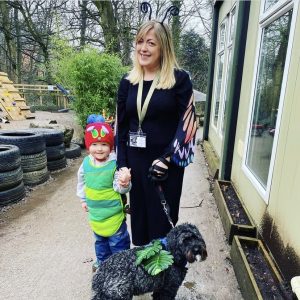
April
The babies took a trip to see the daffodils in the park, the toddlers were knees deep in soil as the garden was re-arranged to support their pouring, filling and digging interest. In the Art Studio in Pre-school we created a shadow puppet theatre so the children could use this as another platform of story telling. They created their own characters and turned them into paper puppets on sticks.
May
Our nursery therapy dog odin turned 5 years old!
June
Our whole nursery came together to have a tea party to celebrate the Queens Jubilee, with parents invited too. The Pre-schoolers performed a little ukulele song we made up together called 'You and Me at the Queen's Jubilee'; a song we still sing 6 months later. Have a listen below-
July
We had a heatwave for our Annual Summer Party, this year we did it a little differently and took over the school field with a carnival parade, steel drum band, BBQ and bouncy castle.
Our school Leavers had their graduation photoshoot.
August
Our many nursery apple tree's were producing plenty of apples, which inspired the children to open an 'Apple Shop'. A wonderful opportunity once again to learn from nature, whilst incorporating role play and maths with real coins.
August also saw the completion of our new staff room, which opened up the previous staff room as a dinning room for our pre-school children in the colder months. The New Staff room is much bigger to accomodate our growing number of staff and is tucked away next to the Art Studio.
September
Jackson Pollock inspired Art in the Art Studio, we splatted paint, experimented with pendulum painting. The results can now be seen in the main entrence of nursery. The September winds provided perfect conditions for some kite flying in Forest School. It was also recycling week in September so our children had a big woodland tidy up to nurture care and respect for our environment and wildlife.
October
Our annual pumpkin picking trip and the festival of lights. Following our pumpkin haul we melted crayons onto the pumpkin when the children expressed they wanted a 'rainbow pumpkin'.
November
We celebrated Nursery Rhyme Week across the rooms in November, the baby room had activities linked to their favourite nursery rhyme '5 little ducks' .
December
And here we are, December 2022, one of the coldest on record. We had a pre-school trip to see Stick Man at the Playhouse Theatre, and they have been combining festive ingredients and smells to make cranberry cordial.
We thank all of our children, parents and staff for another wonderful year. We will look forward to welcoming you all back from 7.30 am Tuesday 3rd of January, but in the mean time we wish you all a happy and healthy festive period.
'The best classroom and richest cupboards are roofed only by the sky'- Margaret Mcmillen
Nathalie
The Importance of Speech and Communication
The pre-school years are an important stage in a child’s language development. It ensures the foundations are in place for later learning, literacy and forming relationships. At Inspirations nurseries we provide a language rich environment incorporating the Reggio Emilia Approach into our pedagogy. The children’s voice is at the heart of our ethos and is encouraged at every opportunity. Group morning meetings enables children to express their thoughts, ideas and experiences, as well as listening to other’s and asking questions which has a positive impact on confidence and self-esteem.
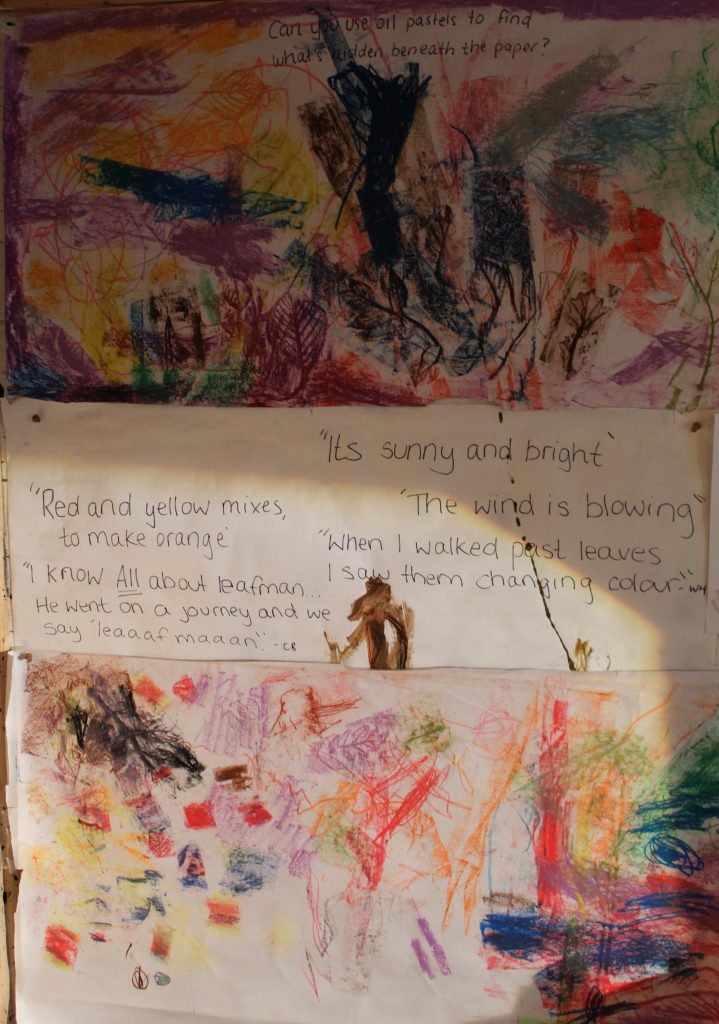
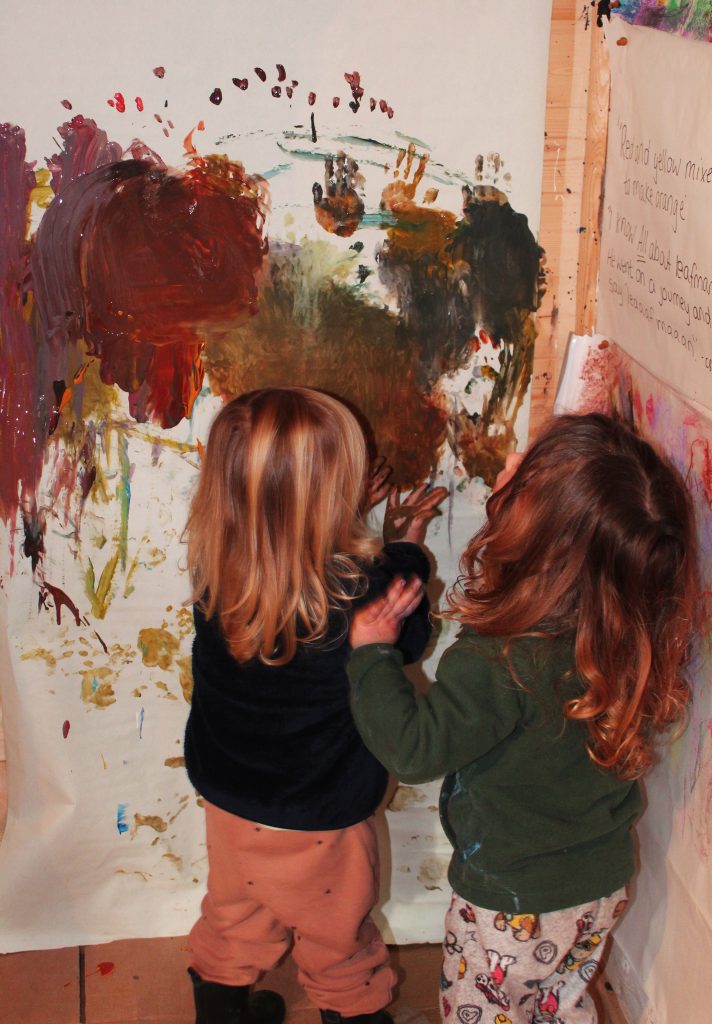
Communication enables children to build relationships. By interacting and playing
using speech and language, a child develops social skills and friendships that
support their well-being. Free choice play using loose parts, role play resources
and provocations allow children to use their own ideas and creativity whilst
encouraging interaction and communication. Children will play together in a mud
kitchen, using real size pans and bun trays chatting and problem solving to find
the perfect amount and size of stones to make cupcakes, or how much water to
add to the soil to make a delicious mud pie.
Children should be seen and heard
As children learn and use new vocabulary, they gain confidence in speech and
expression supporting development of reading and writing skills. We love books
at Inspirations and our practitioners read fiction and non-fiction books regularly
with children, expanding their vocabulary and knowledge as well as may other
skills. More exposure leads to better spelling, grammar, writing, and oral
communication.
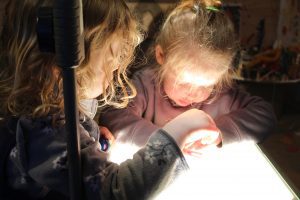
Singing Nursery rhymes with our young children daily helps them to develop an
ear for our language. Both rhyme and rhythm promote children to hear the
sounds and syllables in words, which helps children learn to read. The sooner a
child learns to read, the more opportunities they have to encounter the written
word. Teaching children phonetic sounds is also something we do to support
speech clarity and differentiation as well as reading and writing skills.
Ofsted have re-affirmed the evidence that children with delayed speech and
language are: '...less able to access the curriculum and to articulate their
thoughts and feelings. This can have a negative impact on their personal, social
and emotional development.' Therefore, good speech, language and
communication skills support educational and social achievement for the future of
our children which is why we have such an emphasis in our early years settings.
Children should be seen…and heard.
-Deborah
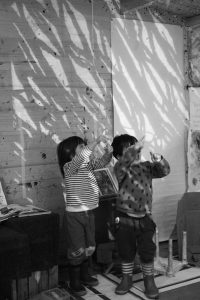
Bad Weather is Good for You
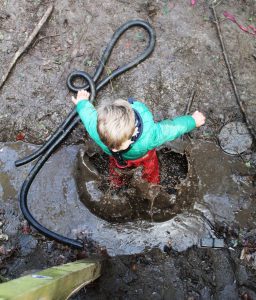
With this relentless rain of recent its easy to slip into the phrase 'bad weather', but there are in fact many benefits to being out in the colder, wetter, windier days. Our children at Inspirations are out in all weathers, embracing all that British weather has to offer, with the help of the right waterproof gear. But what if we told you being out in this weather is actually good for your health?...
The wind and rain can wash away pollution, germs and bacteria. If it’s a muddy forest, even better. Believe it or not, mud is a boon for your health. So rather than taking lengthy detours to avoid a stretch of quagmire, just walk right through it breathing deeply as you go. Mud – be it farmyard or forest floor – is rich in mood-enhancing microbes. Australian researchers found that mice exposed to soil had more diverse microbiomes, a finding mirrored by a Finnish study in which the gut and skin of children playing in plastic-and-concrete playgrounds were compared to those of children whose playground had been rebuilt using a tract of forest floor. In as little as four weeks, the children playing on forest floor had developed more diverse microbiomes. More importantly, the researchers found “parallel changes in the children’s immune systems”, with the muddy children showing greater immunity and fewer coughs and colds for months afterwards. Mud can be slippery, so use walking poles for stability. As you prod at the earth, you’ll also be releasing beneficial bacteria from the soil.
Read the full article here-
The Sticking Table
Much more than just loose parts and glue
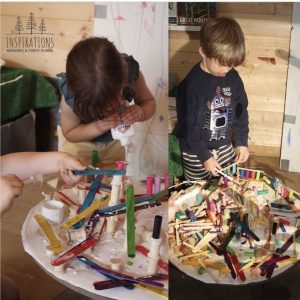 Back in June, shape and structure created from loose parts became a shared interest, the children would make 2D shapes and arrangements with lolly pop sticks. Naturally this progressed into 3D shapes as the children explored the idea of building upwards with bobbins and corks added in.
Back in June, shape and structure created from loose parts became a shared interest, the children would make 2D shapes and arrangements with lolly pop sticks. Naturally this progressed into 3D shapes as the children explored the idea of building upwards with bobbins and corks added in.
We wanted to find a way of making these structures more permanent, a way of their models being able to interact with each other instead of standing alone on a shelf. From here the Sticking table was created!
An old repurposed cable reel became a platform for these structures and ideas to play out, and old objects took on new roles with the help of some glue, a lot of glue in fact.
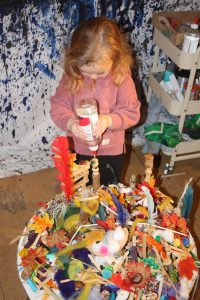
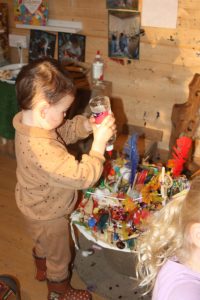
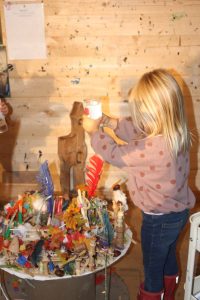
‘Sticky sticky glue’
The glue is poured from squirty bottles from heights, or from close distance, the children watch it pour and dribble. They watch how it builds up and falls off certain surfaces onto a surface below. They practice their aiming skills and try again when the glue doesn’t land where they had in mind. Children love being able to access resources them selves, the joy and independence they get from unravelling tape and pouring glue can’t always be fulfilled at home due to mess and waste, so this was the perfect place for them to pour glue to their hearts content. We used PVA, clear glue, old pen lids destined for the bin, feathers, wool, bobbins and sticks and each week the sticking table carried through with a new story.
The sticking table has been a house, a nest, a city, and a dragon house. For now the sticking table is going though a seasonal autumnal phase as conkers and leaves are added to the mix.
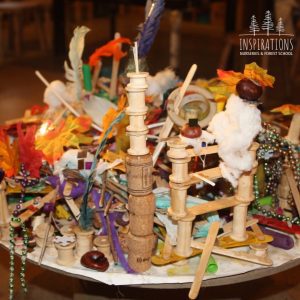
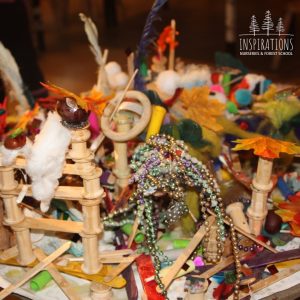
Having a long term project along side other activities can be a great way to allow children to practice and repeat skills, by revisiting ideas from weeks before they are able reflect on their ideas and build confidence. Schemas are a repeated pattern of behaviour that a child will go through whilst discovering how the world works. It is through this urge of repetition our children are given the time and opportunity to extend on their thinking and learning.
It can be hard as educators to have the chance to leave a project out, tidy up time is a necessity particularly in spaces where meal times take place. So the sticking table is the perfect place for them to come back to a scene that has not been tidied away from the last time they were in the Art Studio. The perfect opportunity for them to deepen their cognitive development. Because how else can our children reflect on their work and ideas when they return to a project that has been tidied away.
Only the children can predict where the sticking table will go next, but as each new group of creative minds come together to take ownership of it, it will, no doubt, take on a brand new adventure and identity over the coming weeks and months.
-Nathalie
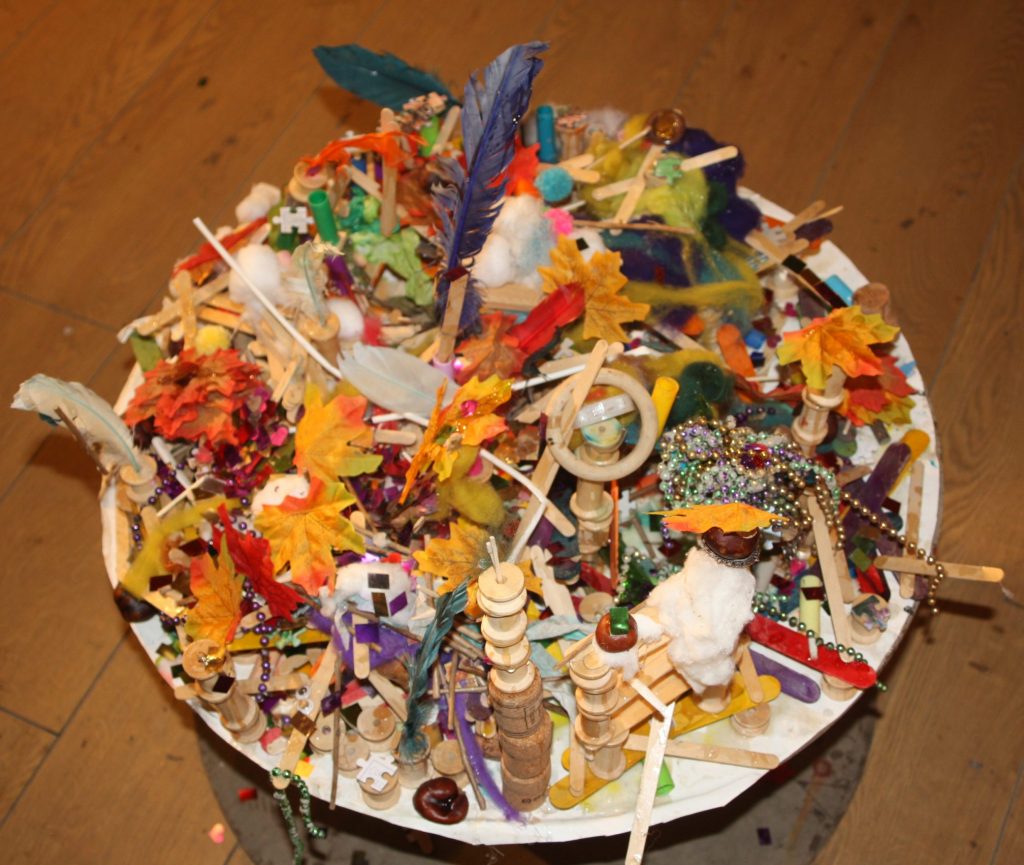
Forest School in the News
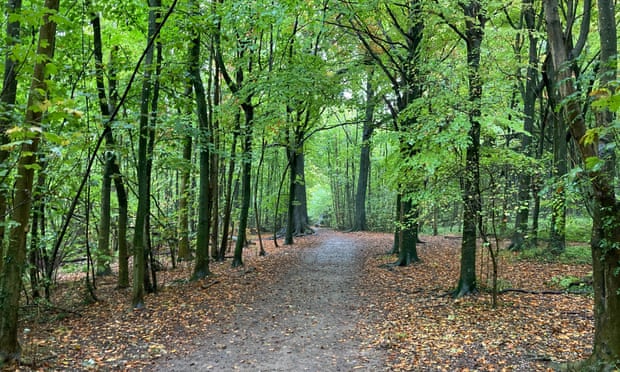
'There’s magic to the woods when it rains. Something otherworldly, Narnia-esque; I can’t imagine why anyone would want to be stuck indoors. It’s wet, but not too wet – the rain falls on leaves above me and most of it channels along branches and trunks. There are few people here, and I can stop and look at things without being noticed. Blackbirds turn leaves, robins sing a sad song, there is, briefly, a chiffchaff.
The woods seem cleaner, fresher during rain. Dust and other residues wash off leaves until they glisten, water pools among the tree roots, and the rest is swallowed by grateful earth. Everything feels new, including me. Is this forest bathing?'
Read the full article here:
